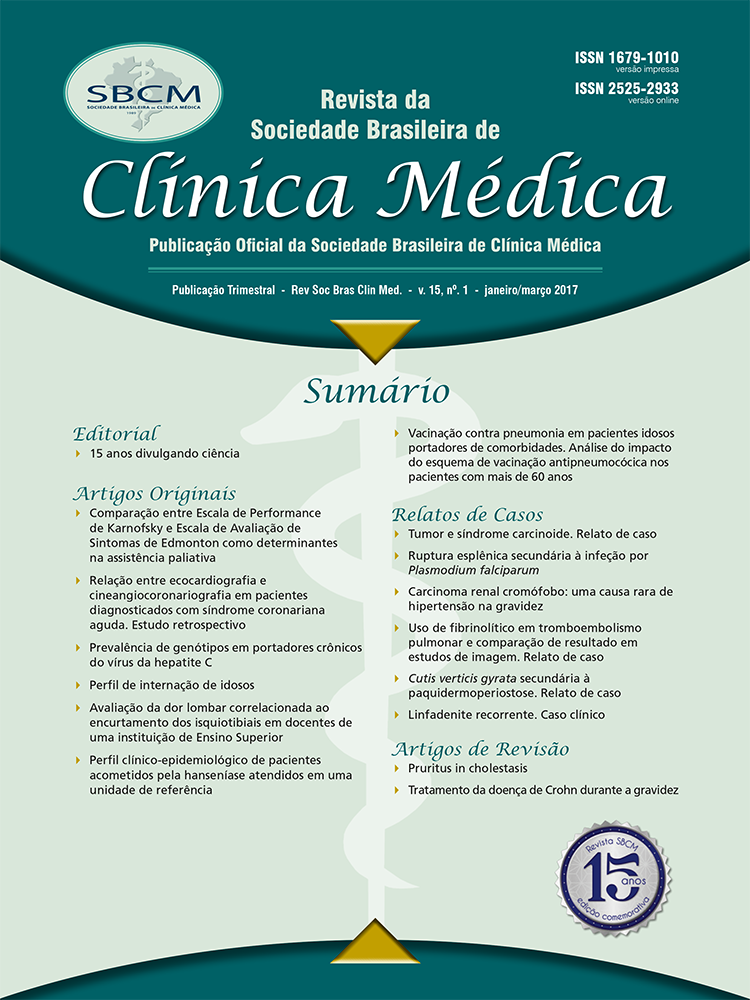Profile of liver donors and recipients in Santa Catarina-Brazil between 2010 and 2011
Main Article Content
Resumo
Objective: To analyze socio-demographic and clinical factors related to liver donation and reception process in Santa Catarina (SC). Methods: Cross-sectional study of 389 medical records, held at the Center for Procurement, Notification and Distribution of Organs and Tissues of Santa Catarina between January 2010 and December 2011. The analysis was performed with the Statistical Package for Social Science software and Pearson’s test.. Results: Of the donors, 46.5% were between 39-59 years (p<0.001). A higher proportion of recipients had a Body Mass Index (BMI) >30, with 28% compared to 11,8% among donors (p=0.001). White people were the majority in both groups (p=0.003). Males were more prevalent in donors and recipients (p=0.009). The causes of death among donors were Traumatic Brain Injury, stroke and others. There wasstatistical significance among the cause of death, systemic arterial hypertension (p<0.001), and drugs (p=0.035). Liver failure among the recipients occurred due to secondary liver disease in 43.1%, infectious liver disease in 29.9%, toxic liver disease in 20.1%, post-transplant complications in 4%, and multiple diagnoses in 2.9%. Among the recipients with secondary liver disease, a higher proportion was in the younger age group as compared to other diagnoses (p=0.011). Secondary liver disease was more prevalent in women (p=0.012). Conclusion: High mortality of young people from external causes kept the profile of donors in Santa Catarina different from that in developed countries, where donors are older and die predominantly from cardiocirculatory causes.
Article Details
Declaração de Direito Autoral
Eu (nome do autor responsável) _______________________________________________ declaro que o presente artigo intitulado ___________________________________é original, não tendo sido submetido à publicação em qualquer outro periódico nacional ou internacional, quer seja em parte ou em sua totalidade. Declaro, ainda, que uma vez publicado na revista Revista da Sociedade Brasileira de Clinica Médica, editada pela Sociedade Brasileira de Clínica Médica, o mesmo jamais será submetido por um dos demais co-autores a qualquer outro meio de divulgação científica impressa ou eletrônica.
Por meio deste instrumento, em meu nome e dos demais co-autores, cedo os direitos autorais do referido artigo à Revista da Sociedade Brasileira de Clinica Médica, e declaro estar ciente de que a não observância deste compromisso submeterá o infrator a sanções e penas previstas na Lei de Proteção de Direitos Autorias (n 9610 19 de fevereiro de 1998) que altera, atualiza e consolida a legislação sobre direitos autorais e dá outras providências. Disponível em: http://www.planalto.gov.br/ccivil_03/leis/l9610.htm
|
_________________________ |
___________________ |
|
Local, data |
Assinatura |
SOCIEDADE BRASILEIRA DE CLÍNICA MÉDICA
CNPJ/MF 062.279.617/0001-45
Rua Botucatu, nº 572, cj. 112, São Paulo, SP
Download da Declaração de Direito Autoral.
